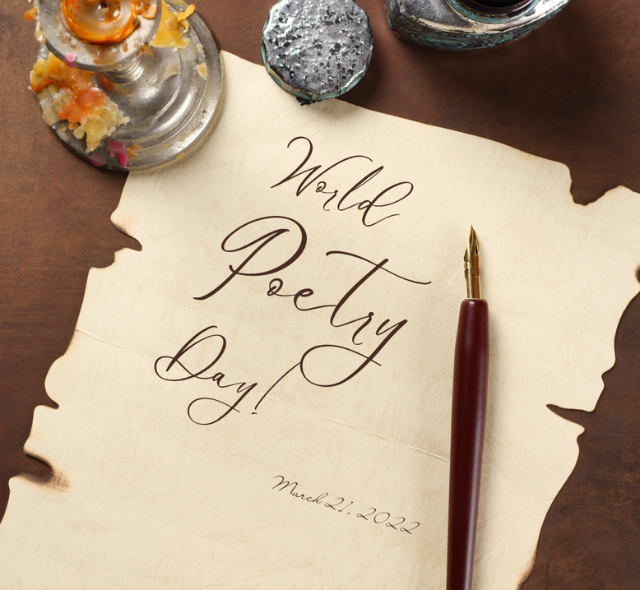- UNIFORM BY SCHOOL
- Girls School Uniform
- Boys School Uniform
- Skirts
- Boys Trousers
- Girls Trousers
- Polo Shirts
- Blouses
- Shirts
- Blazers
- PE Kit
- Clearance


Girls School Uniform


Boys School Uniform


FREE delivery - Ends Monday at Midnight
(X)







It’s World Poetry Day on Tuesday, 21st of March – a day which celebrates one of the world’s oldest forms of storytelling throughout history, across many cultures and continents.
Why is poetry so important for children?
Nursery rhymes are usually the first poems children encounter in life. It’s a way for parents to bond with their children, and teach them the beginnings of language and expression. It’s not just about the words, but the way they’re said and the rhythm of the language.
Poetry gives everyone a voice
It doesn’t matter what your background is or where you’re from, anyone can be a poet. Yes, anyone! You don’t need money, and you don’t even need to read or write – it’s about telling stories and passing them on to the next generation in a way they’ll remember.
Poetry helps with literacy
It helps children form new relationships with words, and learn about rhyming, the similar sounds of words, and the fun of matching words or phrases together. Of course, poems don’t need to rhyme at all – but rhyme will certainly make them more memorable.
Poetry takes many forms
There’s no set ‘recipe’! From the Japanese haiku to Irish limericks and Shakespeare-style sonnets, poetry is an expression unlike any other.
Let’s take a look at some of the most popular kinds of poems:
Haiku
A haiku is a short form poem which originated in Japan. It has a simple format: three lines in total, with five syllables in the first and third lines, and seven syllables in the second line.
Haikus aren’t a rhyming type of poetry (although that’s completely up to you) – instead they tend to focus on natural themes and imagery evoking a specific season.
Here’s an example from Twinkl – perfect for children this spring:
Lambs spring happily
Through the luscious and green fields
Now spring time is here
See, haikus are short and simple. Just remember the 5-7-5 pattern, and you’re good to go!
Limericks
Everyone loves a good limerick, right? These playful, short rhyming poems are a fun way to help children learn all about language and structure.
Limericks are always written using a five-line rhyme structure which is generally known as AABBA – where the first, second, and fifth lines rhyme (the As), and the shorter third and fourth lines feature a different rhyme (the Bs).
The poet Edward Lear wrote many limericks during the Victorian times, just like this one:
There was an Old Man with a beard,
Who said, 'It is just as I feared!
Two Owls and a Hen,
Four Larks and a Wren,
Have all built their nests in my beard!
Sonnets
Did you know William Shakespeare was not only a famous playwright, but a prolific poet too? In fact, he was as famous for his poetry as his plays back in his day! And as with a lot of Shakespeare’s works, his poems influenced the language we still use today.
Shakespeare’s favourite type of poem, the sonnet, features fourteen lines, typically with ten syllables per line, written in an ‘iambic pentameter’ pattern – where short and long syllables sound like a heartbeat! (da-DUM, da-DUM, da-DUM, da-DUM…)
Try remembering this heartbeat pattern when reading Shakespeare’s famous ‘Sonnet 18’ below (‘shall I com-PARE thee TO a SUM-mer's DAY?’)
Shall I compare thee to a summer’s day?
Thou art more lovely and more temperate:
Rough winds do shake the darling buds of May,
And summer’s lease hath all too short a date:
Sometime too hot the eye of heaven shines,
And often is his gold complexion dimmed;
And every fair from fair sometime declines,
By chance, or nature’s changing course, untrimmed:
But thy eternal summer shall not fade,
Nor lose possession of that fair thou ow’st;
Nor shall Death brag thou wander’st in his shade
When in eternal lines to time thou grow’st:
So long as men can breathe or eyes can see,
So long lives this, and this gives life to thee
So why don’t you try writing some poetry as a family this World Poetry Day? You can choose the type of poem you want to write and set a theme (like spring!). You can make it a competition, or simply enjoy a fun activity together, and get your creativity flowing.

